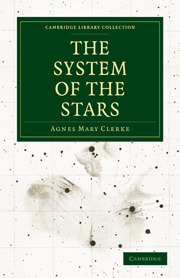Book contents
- Frontmatter
- PREFACE
- Contents
- ILLUSTRATIONS
- ADDENDA
- CHAPTER I THE TASK OF SIDEREAL ASTRONOMY
- CHAPTER II THE METHODS OF SIDEREAL RESEARCH
- CHAPTER III SIRIAN AND SOLAR STARS
- CHAPTER IV STARS WITH BANDED SPECTRA
- CHAPTER V GASEOUS STARS AND NEBULÆ
- CHAPTER VI SIDEREAL EVOLUTION
- CHAPTER VII TEMPORARY STARS
- CHAPTER VIII VARIABLE STARS OF LONG PERIOD
- CHAPTER IX VARIABLE STARS OF SHORT PERIOD
- CHAPTER X THE COLOURS OF THE STARS
- CHAPTER XI DOUBLE STARS
- CHAPTER XII VARIABLE DOUBLE STARS
- CHAPTER XIII STELLAR ORBITS
- CHAPTER XIV MULTIPLE STARS
- CHAPTER XV THE PLEIADES
- CHAPTER XVI STAR CLUSTERS
- CHAPTER XVII THE FORMS OF NEBULÆ
- CHAPTER XVIII THE GREAT NEBULÆ
- CHAPTER XIX THE NATURE AND CHANGES OF NEBULÆ
- CHAPTER XX THE DISTANCES OF THE STARS
- CHAPTER XXI TRANSLATION OF THE SOLAR SYSTEM
- CHAPTER XXII THE PROPER MOTIONS OF THE STARS
- CHAPTER XXIII THE MILKY WAY
- CHAPTER XXIV STATUS OF THE NEBULÆ
- CHAPTER XXV THE CONSTRUCTION OF THE HEAVENS
- APPENDIX.—TABLES OF STELLAR DATA
- INDEX
- Plate section
CHAPTER V - GASEOUS STARS AND NEBULÆ
Published online by Cambridge University Press: 05 July 2011
- Frontmatter
- PREFACE
- Contents
- ILLUSTRATIONS
- ADDENDA
- CHAPTER I THE TASK OF SIDEREAL ASTRONOMY
- CHAPTER II THE METHODS OF SIDEREAL RESEARCH
- CHAPTER III SIRIAN AND SOLAR STARS
- CHAPTER IV STARS WITH BANDED SPECTRA
- CHAPTER V GASEOUS STARS AND NEBULÆ
- CHAPTER VI SIDEREAL EVOLUTION
- CHAPTER VII TEMPORARY STARS
- CHAPTER VIII VARIABLE STARS OF LONG PERIOD
- CHAPTER IX VARIABLE STARS OF SHORT PERIOD
- CHAPTER X THE COLOURS OF THE STARS
- CHAPTER XI DOUBLE STARS
- CHAPTER XII VARIABLE DOUBLE STARS
- CHAPTER XIII STELLAR ORBITS
- CHAPTER XIV MULTIPLE STARS
- CHAPTER XV THE PLEIADES
- CHAPTER XVI STAR CLUSTERS
- CHAPTER XVII THE FORMS OF NEBULÆ
- CHAPTER XVIII THE GREAT NEBULÆ
- CHAPTER XIX THE NATURE AND CHANGES OF NEBULÆ
- CHAPTER XX THE DISTANCES OF THE STARS
- CHAPTER XXI TRANSLATION OF THE SOLAR SYSTEM
- CHAPTER XXII THE PROPER MOTIONS OF THE STARS
- CHAPTER XXIII THE MILKY WAY
- CHAPTER XXIV STATUS OF THE NEBULÆ
- CHAPTER XXV THE CONSTRUCTION OF THE HEAVENS
- APPENDIX.—TABLES OF STELLAR DATA
- INDEX
- Plate section
Summary
The fifth spectral class is at present the most restricted of all, but its numbers are being rapidly augmented both by photographic and by improved visual means. The objects belonging to it are distinguished by the display in their spectra of isolated bright lines on a more or less perfectly continuous background, sometimes, however, also interrupted by dark lines or bands. They present us then with a triple combination—a direct gaseous spectrum, a reversed gaseous spectrum, and a spectrum due to glowing solid or liquid matter, all simultaneously made manifest by the unrolling, as it were, of a single scroll, yet each originating under very different conditions. The investigation of what those conditions are constitutes one of the most important tasks of physical sidereal astronomy.
The state of bright emission is in some stars normal, in others it only supervenes as part of a great general increase of light. This is the case with many ‘temporary’ and periodical stars, their blazing atmospheric constituents being almost invariably hydrogen and helium. Objects, on the other hand, showing bright lines with approximate constancy, can be discriminated into two varieties, according as they give or withhold evidence of the presence in them of hydrogen.
The first specimen of a ‘gaseous star’ was made known by Father Secchi's discovery, August 19, 1866, of the green line (F) of hydrogen conspicuously bright in γ Cassiopeiæ, the middle star of five of the second and third magnitudes grouped into the shape of a W on the opposite side of the pole from the Great Bear.
- Type
- Chapter
- Information
- The System of the Stars , pp. 66 - 81Publisher: Cambridge University PressPrint publication year: 2010First published in: 1890

